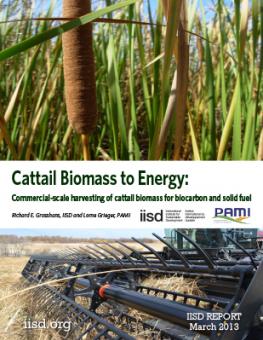
Cattail Biomass to Energy: Commercial-scale harvesting of cattail biomass for biocarbon and solid fuel
The International Institute for Sustainable Development (IISD) has explored the harvesting of cattail (Typha spp.) as a component of watershed nutrient-management to capture and remove phosphorus, and the use of the harvested biomass as a sustainable renewable biomass feedstock for energy and bioproducts.
Previous IISD research in the Netley-Libau Nutrient-Bioenergy project performed harvesting and processing on a smaller scale to determine potential for phosphorus (P) capture and use of the biomass for energy. IISD, in collaboration with the Prairie Agricultural Machinery Institute (PAMI), began cattail harvest trials in 2012 using commercial-scale equipment on cattail stands growing in wet and low-lying areas. Cattails were cut and harvested in the ditches along Highway #1 and at Pelly’s Lake using commercially available grain and forage equipment, a wetland area near Holland, Manitoba. Cattails were cut and windrowed at both locations using a windrower swather from MacDon Industries Ltd., a cooperating partner in the project. A medium square baler was used to collect the cattails from the ditches, and round balers were used to collect the cattails from Pelly’s Lake. The conditions at the specific sites dictated the type of baler required.
The growing season during which the cattails were harvested had below-normal precipitation, which made cutting the cattails with commercial grain harvesting equipment easier. Baling operations were hampered by above-normal precipitation in the fall. Almost 300 tonnes of cattail was harvested in 2012, with an estimated 240 kilograms of P captured and removed. A cost estimate was performed based on the field operations necessary to collect the cattails from both the ditches and Pelly’s Lake site, estimating “research cost” and contracting rates according to the Manitoba guidelines. A premium may be required when using agricultural equipment to account for risk associated with operating outside of typical field conditions. Successfully managing water levels would greatly enhance efficiencies and costs.
This first phase of the Cattail Biomass Harvesting and Biocarbon project successfully demonstrated cattails can be harvested as a biomass feedstock using conventional grain and forage equipment, particularly if the conditions are suitable. Wetland areas are especially productive and produce significant quantities of cattails. A total of 60 cattail bales were shipped to Saskatchewan to produce biocarbon, which will be assessed for energy value, and used for field-scale agricultural crop fertilizer trials and greenhouse fertility and soil trials.
Participating experts
You might also be interested in
Cattail (Typha spp.) Harvesting in Manitoba: A legislative and market analysis for operationalization and carbon emission offsets
What to Expect at Plastics INC-5
Q and A with Tallash Kantai of Earth Negotiations Bulletin on INC-5.
The Chemical Analysis of Fresh Water (Third Edition)
This publication describes the protocols used in the IISD Experimental Lakes Area Analytical Service Laboratory for the measurement of chemical constituents in freshwater samples.
IISD Annual Report 2023–2024
While IISD's reputation as a convenor, a trusted thought leader, and a go-to source on key issues within the sustainable development field is stronger than ever, the work happening outside the spotlight is just as valuable.